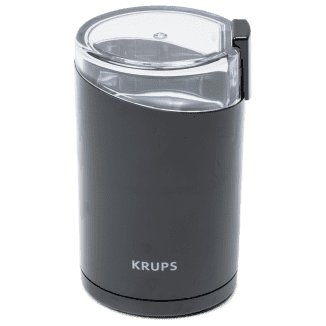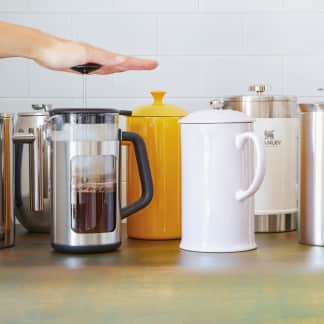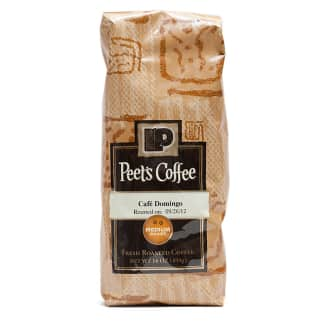Coffee aficionados will tell you that a good grinder is critical to getting the best cup of coffee, claiming that all the coffee particles need to be about the same size to get a smooth, even brew free of overly bitter or harsh flavors. To achieve this, coffee shops and dedicated home brewers often use burr grinders, a style of coffee grinder that works like a pepper mill and forces each bean to pass through a set of metal rings called burrs. The best of these machines can produce an extremely even grind, allowing baristas to provide consistent cups of coffee to their customers day after day.
Many people instead choose blade grinders, which are compact and cost a fraction of the price. These work like tiny food processors, with a blade that spins to chop the coffee beans. The longer you hold down the button, the finer the coffee gets. But which blade grinder is best? To find out, we rounded up some promising models, using each to grind enough beans to make one, four, and 10 cups of coffee. We used the grinders to achieve a fine, medium, and coarse grind with both light-roasted and dark-roasted beans. Finally, we had testers—ranging from novices to coffee experts—operate each grinder to gauge its user-friendliness.

Pulse, Shake, Repeat: How To Use A Blade Grinder
Which grind size you aim for depends on your brewing method: coarse grind for French press, medium grind for drip machines, and fine grind for espresso. However, with our lineup of blade grinders, we found that simply holding down the “on” button until some of the coffee looked to be the right consistency often led to uneven results, with powdery clumps of overprocessed coffee interspersed with untouched whole beans. In the coffee industry, the powdery bits are called fines and the underprocessed beans are known as boulders. While we’ve learned that grind evenness isn’t the only factor in brewing good coffee, leaving whole beans in your brew basket is a waste—those unprocessed beans are too big to add any flavor in the short time it takes to brew a pot of coffee.

Christopher Hendon, assistant professor of computational materials chemistry at the University of Oregon and author of Water for Coffee (2015), told us that if you simply hold down the grind button, some beans end up overground, while others never come in contact with the blade. “There’s a floating effect, where the big pieces float on top of the swirling fines and never get broken down,” Hendon said. To combat this, experts recommend pulsing the grind button and shaking the grinder in between pulses to redistribute the grounds.

We adopted a pattern of shaking the grinder in between 1-second pulses. For some of the grinders, this helped even out the grind. We confirmed this by using a device called the Kruve Sifter—a handheld particle separator used by coffee professionals in the World Barista Championship—to separate out the boulders and fines. What was left over were the medium pieces, the similar-size particles that are the optimal size for a medium grind. We found that the blade grinders in our lineup produced coffee that ranged from 30 to 46 percent medium particles, compared to nearly 90 percent in our top-rated burr grinder.
However, shaking and pulsing weren’t enough to improve the performance of some blade grinders; we still found whole and partially processed beans in three of the models in our lineup despite pulsing, shaking, and grinding longer.

Does Blade Height Matter?
Blade grinders bear many similarities to food processors, and in our testing of the latter, we learned that the height of the blade is crucial. We measured this distance in each of the blade grinders; it ranged from 5 to 14.1 millimeters. The average length of a coffee bean is 10 millimeters, and we found that models with more than 9 millimeters between the blade and the base of their grinding chamber ground coffee less evenly, allowing whole beans to pass under the blade and never get fully broken down. Our favorite grinder had just 6.4 millimeters of space, ensuring that—with proper shaking—we never saw any whole beans in the grind. It achieved the most even grind of any model in our lineup, at 46 percent medium pieces.
Capacity Is Important
The amount of beans you grind depends on how much coffee you’re making; a good grinder should be able to process anywhere from a single serving to a full pot’s worth of beans. To test capacity, we used the specifications for brewing a full pot (10 servings) of coffee in our winning automatic drip coffee maker, which requires just under 70 grams (about 1 cup of ground coffee). Most of the grinders were able to accommodate this amount, but two struggled. One just barely contained all the beans, and with the grinding chamber packed so full, the grinder struggled to break them down. The other could fit only 48 grams of coffee beans (enough to brew about seven cups), so we’d have to grind in two batches if we wanted a full pot. While many of us are probably not brewing a full pot every day, smaller-capacity grinders proved more difficult to use even when they weren’t overflowing: Grounds flew over the sides when we opened the lids, and we had to be extra-careful not to spill beans all over the counter when we loaded these petite grinders. Our favorite grinder, on the other hand, had a capacity of 75 grams, which made it more versatile and tidier.

Innovative Designs Fall Flat
Many cooks use a blade grinder not only to grind coffee but also to process whole spices such as cumin or coriander seeds. However, traditional blade grinders have the grinding chamber built into the base, which makes them hard to clean. For this reason, we recommend having a separate grinder for spices.
Two products in our lineup attempted to solve this problem with removable and/or interchangeable grinding chambers. Similar to a blender carafe that sits on a base, these grinders featured a small metal grinding chamber that could be removed from the sensitive electronic base and either washed or swapped out for another grinding chamber. This allows you to grind spices and coffee in the same machine without the potential for a cumin-flavored cup of coffee. While this is a good idea in theory, these innovative grinders were messy: The coffee grounds sprayed up and over the grinding chamber and then got sucked down into the base, meaning a lot of our coffee ended up underneath the grinding chamber, not inside it. We preferred the simpler, cleaner operation of traditional-style blade grinders. (Ultimately, we still recommend buying a separate grinder for spices.)
We considered other design differences as well, such as the ease of holding down the grind buttons, where these buttons were placed, and how easy it was to monitor the coffee as it ground. Some grinders had buttons or shaded lids that partially obscured our view of the grinding. Others were so difficult to press down that we had to grip the grinder with both our hands. We liked responsive grind buttons, a clear lid, and offset buttons so our hands didn’t block our view of the grind.
The Best Budget Coffee Grinder: Krups Coffee And Spice Grinder
Our favorite blade grinder was once again the Krups Coffee and Spice Grinder. It was incredibly simple to use and had a roomy grinding chamber and a crystal-clear lid that let us monitor the grinding. How did the coffee compare to coffee ground in our favorite burr grinder? We held four blind tastings with the help of coffee experts—including baristas, coffee shop owners, and roasters—and every time, tasters were split on which coffee they preferred. While we still prefer burr grinders for their consistency and hands-off grinding, we found that you truly can get a great cup of coffee with a blade grinder.
- Neat, contained grinding
- Clear lid so we could see when coffee was ground to desired consistency
- Short distance between blade and bottom of grinding chamber, which helps ensure that all beans are ground properly
- Roomy grinding chamber that can hold enough beans to make 10 cups of coffee (70 grams of ground coffee for our top-rated drip coffee maker)
- Works just as well when grinding beans for 1, 4, or 10 cups of coffee
- Grind enough coffee to make 1 and 4 cups of drip coffee, using 15-second grinding time (medium grind)
- Grind enough coffee to make 1 and 4 cups of French press coffee, using 10-second grinding time (coarse grind)
- Grind enough coffee to make 1, 4, and 6 shots of espresso, using 30-second grinding time (fine grind)
- Fill to capacity and grind coarse, medium, and fine
- Sift coffee grounds using Kruve Sifter outfitted with 400-μm and 900-μm screens
- Weigh sifted grounds to calculate percentage of large, medium, and small pieces
- Grind 10 grams of coffee for 15 seconds for medium grind, sift in Kruve Sifter, weigh resulting beans, adjust grind time, and repeat until highest percentage of medium particles is achieved
- Inspect shape, length, height, and design of blades
- Have novices and experts grind coffee to medium consistency
- Hold 4 blind tastings with panel of 21 tasters sampling black drip coffee made using winning blade grinder versus highest-rated and lowest-rated burr grinders
- Measure capacity of grounds chamber
- Winner Only: Grind small and large amounts of cumin seeds, coriander seeds, and whole cardamom
















